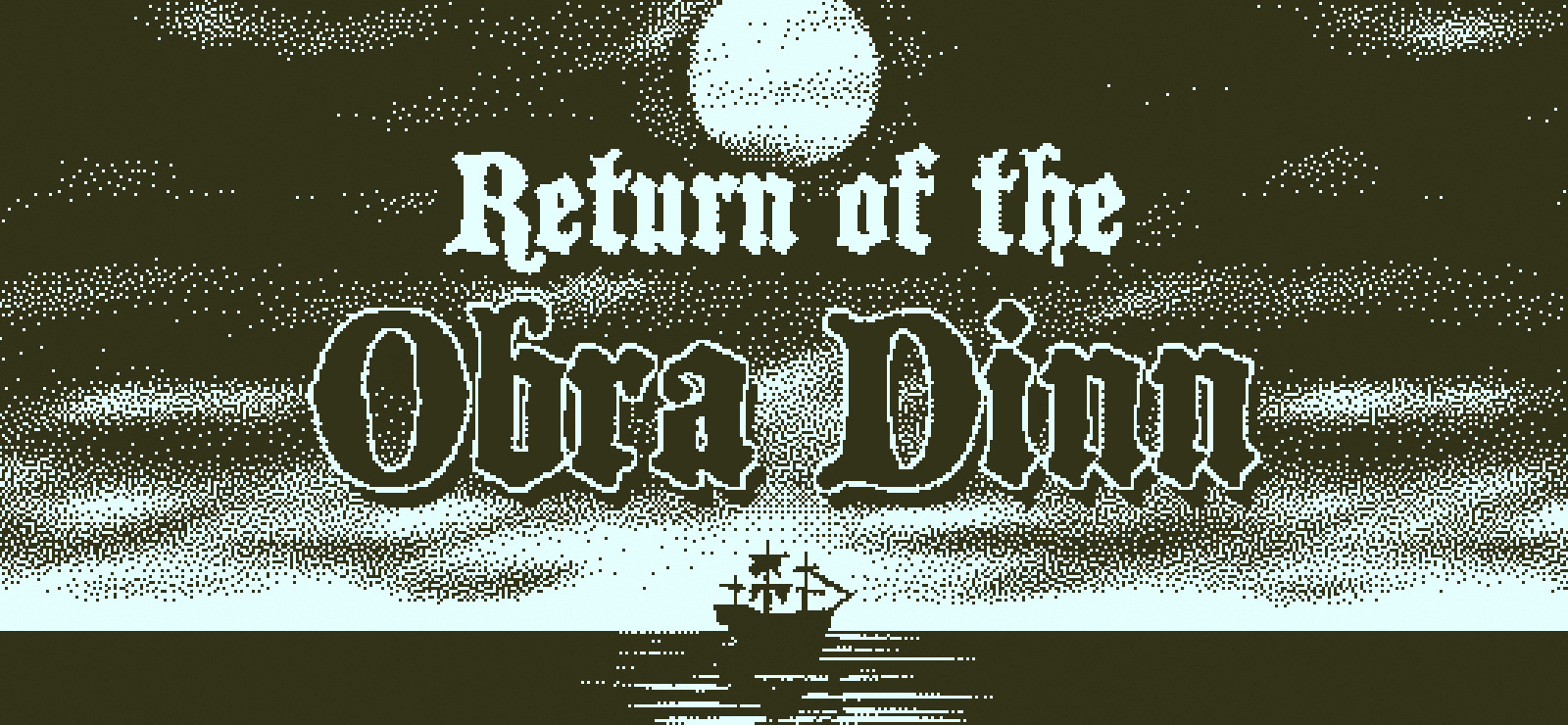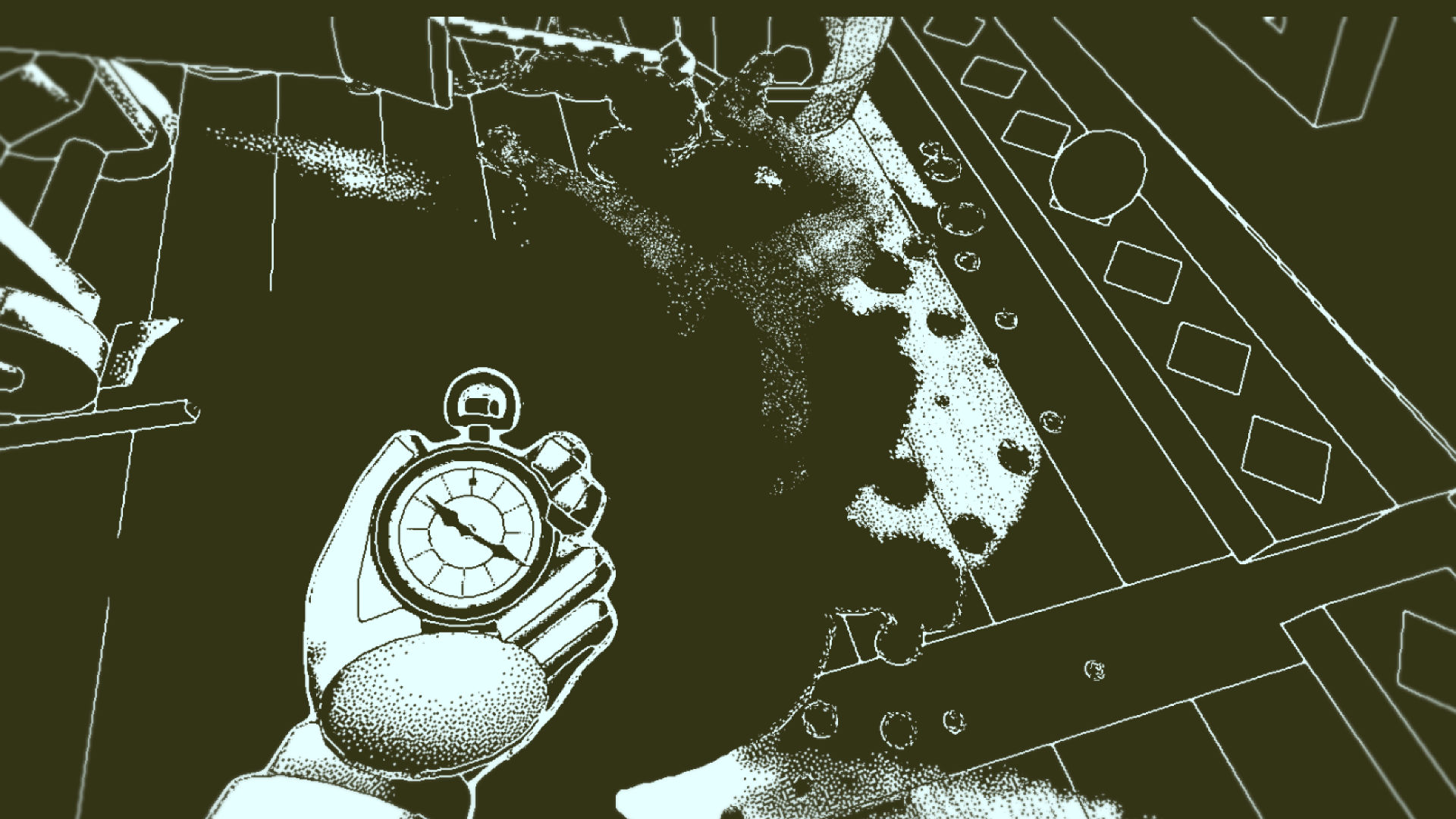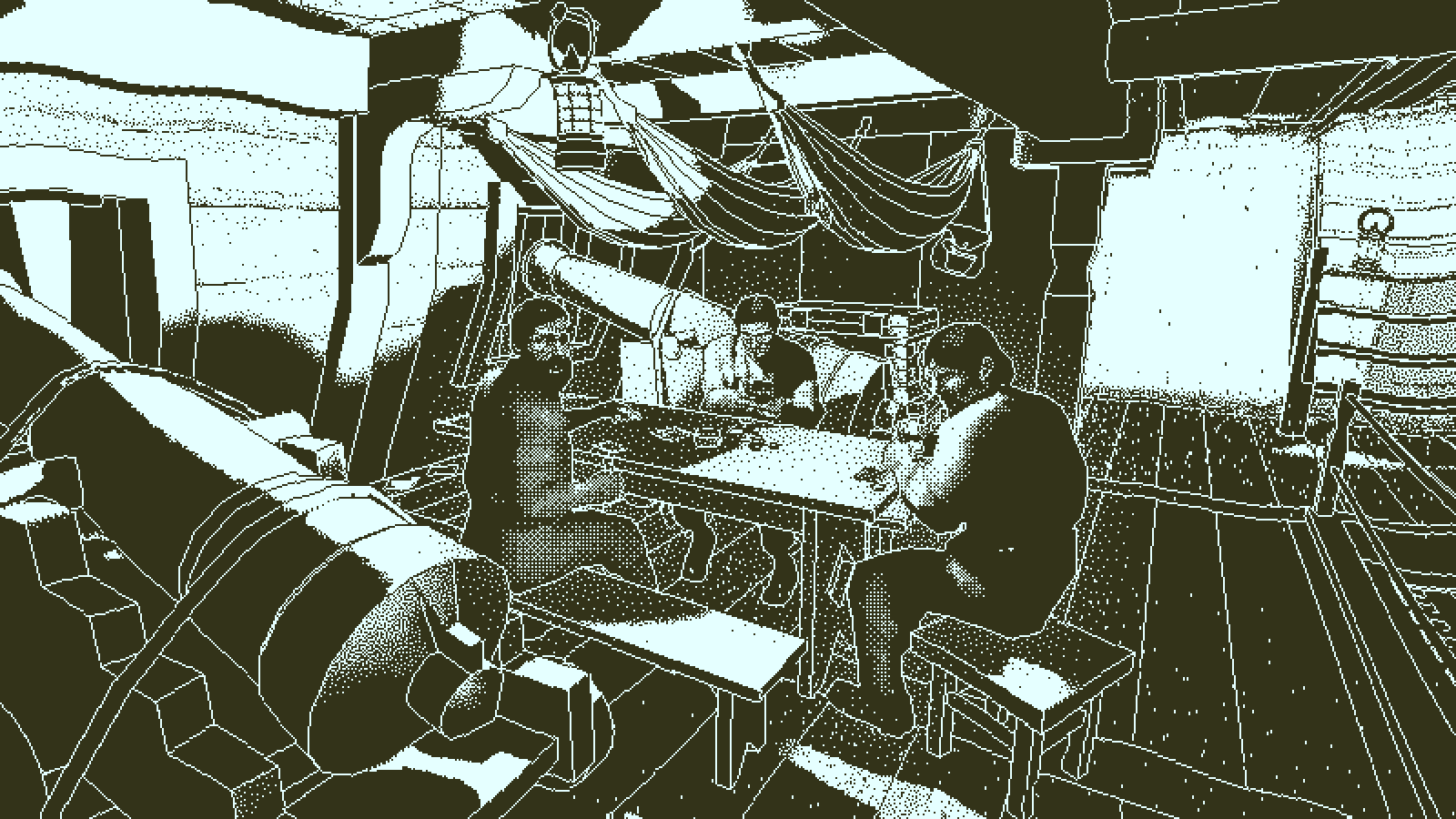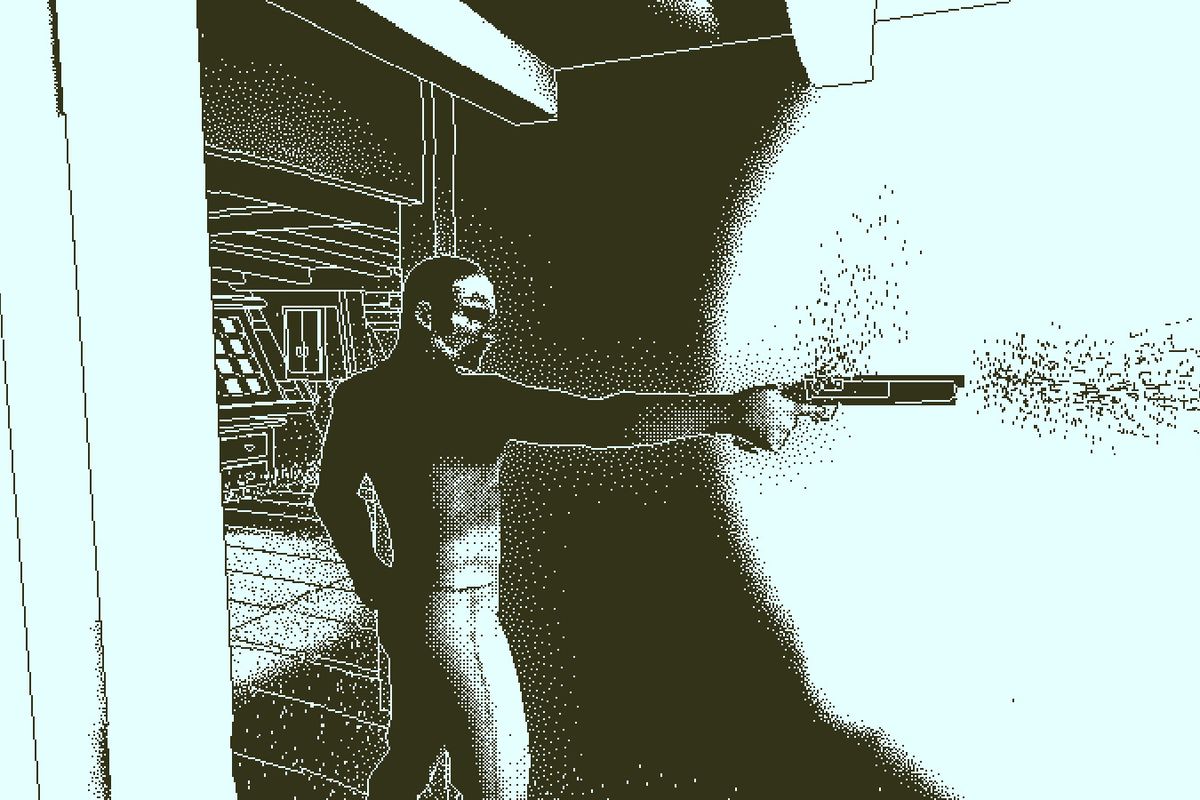
You return to the scene of the crime for the third time. There is a coarse bearded man who is mid sword thrust, his blade stabbing into the belly of a second crew member. A witness to the murder yells out a name, indicating that the stabbed man is likely named Paul. However, you still have no idea who the attacker is. After scribbling down some stray notes you wander over to the exit of the memory, intent on returning here again once you have new information. But then you notice the stairs, ones that lead into the underbelly of the Obra Dinn. Changing course you go deeper into the ship, suddenly witnessing a conspiracy underway.
You had seen the after-effects of this plot, but now you can much better understand the likely chain of events. By analyzing the scene you are able to better understand the mutiny you had previously witnessed. Returning to your notes something suddenly clicks into place. You find yourself recording a new name and a cause of death. As you finish entering this information into your ledger, you hear a familiar audio cue that acknowledges that you have determined the deaths of three more crew members of this doomed vessel. A smile appears on your face as you inch closer to understanding what really happened to the crew of the Obra Dinn.
This is just one example of a potential interaction in the open-ended detective game The Return of the Obra Dinn, the latest by the indie auteur Lucas Pope. Like Pope’s previous work Papers Please, Obra Dinn is a singular puzzle game that puts the player in the role of an unconventional video game protagonist. Here you play as an insurance agent for the East India Trading Company in 1807. She is summoned when an empty vessel is discovered months after its planned arrival, a clear violation of its contract. The ship is called the Obra Dinn, and you are tasked with discovering the fates of all sixty of its crew and passengers.

Luckily, you have an exceedingly useful tool at your disposal. One of the few survivors of this ordeal gifts you a seemingly magical stopwatch which offers a window into the past. It can only be activated when you find a body, but it will reliably display the final moment of these unfortunate crew member’s existences. You can freely explore the surrounding area of this petrified moment, picking up on important clues that will aid in discovering identities. You can also hear a few seconds of dialogue that lead up to their death, giving important insights into the situation. Another vital asset is a ledger with every crew member’s name, occupation, and nationality. Finally, you have a series of unmarked illustrations of everyone who was initially on the ship, which must be matched to the names on the ledger.
While it may sound as though you are gifted with an abundance of tools and hints, in the vast majority of cases, the death scenes do not include names or directly relevant dialogue. In the beginning, the massive ledger of names and occupations intimidates through its sparseness, the prospect of discovering everyone’s titles and cause of death a seemingly insurmountable task. Although it’s possible to intuit around a third of the crew just by going through all of the memories for the first time and lining up the obvious identities the rest are not so easy. Once these more obvious characters are out of the way, the true challenge of the game begins to reveal itself.

While most puzzle and detective games are divided into levels with a relatively limited possibility space, all of this game’s information is interconnected. There are chapters, but the hints from one area carry over to the next, meaning every single scene could have potential relevance towards any other murder. Since there is such an abundance of vague information taking significant leaps of logic and making grand deductions is encouraged. To keep everything straight, it is likely that you will have to take notes, keeping track of specific details like if an individual is performing a certain job, or all of the possible causes of death for an ambiguous murder.
It’s this combination of elements that makes Obra Dinn’s problem solving so uniquely gratifying. At first many of the deaths and identities seem impossible to deduce, but through extensive sleuthing it is possible to put together tenuous assumptions. By combing through the various scenes you can build a case for the identity of the crew members. You can figure out a crew members occupation through keeping tracking of them while they perform jobs on the ship, allowing you to slightly hone in on who they are. For instance, you may notice that a certain individual seems to frequently be near or waiting on a crew member you assume is an officer. From this, you can infer that they are the officer’s steward. Some clues are subtle but extremely important, such as one that lets you directly utilise the numbers on the name ledger to eliminate the possible identities of late-stage victims. Did a murderer kill someone because their brother was previously done in by the victim? Look at the ledger and find two people with the same last name. Figure out which is which studying each and inferring their job on the ship. Do a group of people keep constant company with each other, a few of which you’ve heard speak Russian? It can be assumed that these folks are the Russians on the ledger, and observing their duties may directly reveal the identity of one who doesn’t share the same profession with the rest.

There is a remarkably free-form quality to the problem-solving that stems from the inter-connectivity of the clues. Although there was a specific order in which I uncovered the names and fates of the members of the ship, that order was far from prescribed. Going through all of the scenes after piecing together the puzzle only enforces this notion. A plethora of subtle hints fills the world, each slyly indicating the roles and identities of everyone aboard. This level of detail not only makes unravelling the mystery that much more satisfying but is actually necessary given how unguided the experience is. Sure, early on the death sequences daisy chain from one to the next, setting up linear paths of discovery. But beyond this, there are very few nudges from the creator, letting us fully inhabit the role of a detective.
In recent years, there has been something of a push for more “hardcore” games, a reaction to the perceived over-simplification of big budget titles. FromSoftware’s Souls titles embody this movement, their punishing nature forcing players to fully engage with their core systems. While I love the fact that the gaming space is now broad enough to provide experiences of all difficulty levels, I admit that I find myself far more engaged when I am forced to immerse myself in the logic of the world with minimal aid from the developer. Obra Dinn feels like a non-action oriented extension of this philosophy. Pope respects his audience by avoiding any form of railroading or overly explicit instruction. And because of this every time you solve a mystery, it doesn’t feel like a scripted event, but a genuine revelation that was uncovered due to your ingenuity.

Aiding in the air of discovery is an ostentatious sense of style that helps define the experience. An homage to early computer games, the visual trappings of Obra Dinn employ a heavily shaded impressionistic aesthetic. When combined with its swashbuckling soundtrack, there is an overriding sense of style that helps add cohesion to the story and world. As previously mentioned, there is also a gratifying audio cue that plays when you discover the fates of three new crew members, a Pavlovian dog bell that got me to immediately dive back into the detective work again and again.
I feel fairly confident in saying that there isn’t another game like Return of the Obra Dinn out there. Through its thorough world-building and minimal guidance, it sets up a dense mystery that requires genuine deduction and problem solving to unravel. In most cases, a recipe this original would likely lead to sequels or follow-ups. But based on how eclectic Lucas Pope’s catalogue is shaping up to be, it feels somewhat unlikely that we will ever see a direct continuation. Pope has designed a meticulous world with a subtle but masterfully crafted breadcrumb trail. The threads of this mystery are gently spun into a complete whole, a threadwork that the player creates through their discoveries For those with any passing interest in mystery stories, problem-solving, or singular game design, The Return of the Obra Dinn offers an immersive puzzle game that is uniquely rewarding.





I just bought this game, and this post definitely made me more excited to finally play it! It is also nice to keep all of this in mind for if… when I feel like I’m getting stuck Is there any way to make notes in-game or did you keep a real notebook while playing?
Is there any way to make notes in-game or did you keep a real notebook while playing?